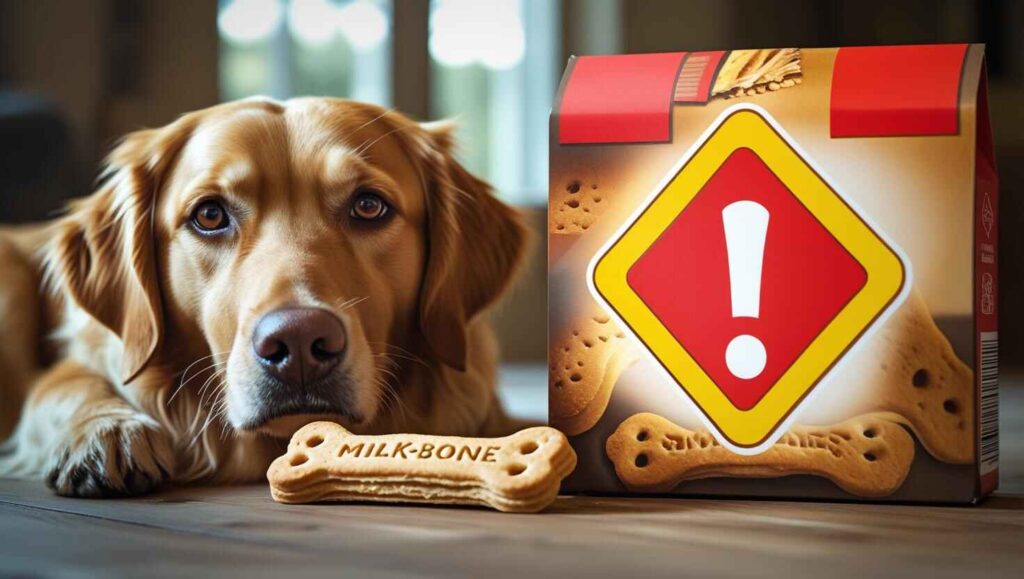🦴 What Are Milk Bones?
Milk-Bones are one of the most iconic dog treats in the pet industry. Introduced in 1908, these crunchy bone-shaped biscuits are marketed as tasty snacks that also support your dog’s dental hygiene.
They’re made from ingredients like:
- Wheat flour
- Beef or chicken meal
- Milk
- Preservatives (like BHA)
- Added vitamins and minerals
You can find them in various sizes, flavors, and formulas (like “Soft & Chewy” or “Gravy Bones”) tailored for dogs of different sizes and needs.
🧬 Nutritional Breakdown of Milk Bones
Let’s take a closer look at what your dog is actually consuming in one Milk-Bone treat.
| Nutrient | Average per Treat |
|---|---|
| Calories | 20–125 (size-dependent) |
| Protein | ~12% |
| Fat | ~5% |
| Fiber | ~2% |
| Added Nutrients | Calcium, Vitamin D, Zinc, Iron |
Although Milk-Bones offer basic nutrition, they are not a substitute for a balanced dog diet.
✅ Benefits of Milk Bones for Dogs

1. Dental Health Support 🦷
Milk Bones help reduce tartar and plaque build-up as your dog chews, promoting better dental hygiene. Their crunchy texture scrubs away debris and can freshen breath.
2. Training & Behavior Aid 🐶
These treats are excellent for reward-based training. Dogs love the taste, making them effective motivators during obedience training or behavioral reinforcement.
3. Convenience and Shelf Life 📦
Milk-Bones are easy to store, carry, and use. Their long shelf life makes them a go-to treat for many dog owners.
⚠️ Potential Drawbacks of Milk Bones
1. Controversial Ingredients 🧪
Some Milk Bone varieties contain:
- BHA (Butylated Hydroxyanisole): is a common preservative used to keep treats fresh, but it’s sparked concern because studies on lab animals have shown a possible link to cancer.
- Wheat & Corn: Common allergens for sensitive dogs.
- Artificial colors & flavors
While the FDA deems these ingredients safe in small amounts, some pet parents prefer more natural alternatives.
2. Allergic Reactions in Some Dogs 🐾
Dogs with grain or dairy sensitivities may experience:
- Itchy skin
- Digestive upset
- Ear infections
If your dog has allergies, it’s super important to take a moment and check the ingredient list before giving them any treat.
3. Overfeeding Risk ⚖️
These treats are calorie-dense. Giving too many treats—especially to small or less active dogs—can easily lead to weight gain and throw off their overall nutrition.

🐕 Are Milk Bones Safe for All Dog Breeds?
Generally, yes—but not all dogs react the same way. Toy breeds or senior dogs may struggle with harder treats. Likewise, large dogs may not benefit from smaller bones, as they can be swallowed whole.
Here are some general guidelines:
| Dog Type | Recommended Milk Bone Type |
|---|---|
| Small Breeds | Mini or Soft & Chewy |
| Medium Breeds | Regular |
| Large Breeds | Large or Jumbo |
Always supervise your dog when giving any treat.
🩺 Vet Opinions on Milk Bones
Most veterinarians agree that occasional use of Milk Bones is fine for healthy dogs. However, they advise:
- Reading labels
- Limiting treats to 10% of daily calories
- Watching for allergic reactions
Dr. Rachel Barrack, a certified veterinary acupuncturist, says:
“Treats like Milk-Bones are okay in moderation. But always prioritize whole food treats and check for questionable preservatives.”
For a vet-reviewed analysis, visit American Kennel Club’s Treat Safety Guide.
For a vet-reviewed analysis, visit American Kennel Club’s Treat Safety Guide.
🧮 How Many Milk Bones Can Dogs Have?
Treat quantity depends on your dog’s:
- Weight
- Activity level
- Overall diet
As a general rule:
| Dog Weight | Max Treats/Day |
|---|---|
| <10 lbs | 1 small Milk-Bone |
| 10–30 lbs | 2–3 small/1 medium |
| 30–70 lbs | 2–4 medium |
| 70+ lbs | 3–5 large bones |
Always subtract treat calories from your dog’s total daily intake to avoid overfeeding.
🥕 Alternatives to Milk Bones
If you’re concerned about ingredients or allergies, consider these healthier options:
- Freeze-dried liver treats
- Carrot sticks or apple slices (no seeds!)
- Homemade oatmeal peanut butter dog biscuits
- Dental chews with VOHC seal
These offer fewer additives and may be better for sensitive tummies.
❓ Frequently Asked Questions (FAQs)
Q1. Are Milk Bones made in the USA?
Yes, Milk-Bones are made right here in the U.S. and are produced in facilities that follow FDA safety guidelines.
Q2. Can puppies eat Milk Bones?
Puppies over 6 months can eat smaller Milk-Bones. However, always check packaging for age recommendations.
Q3. Do Milk Bones cause cancer?
There’s no direct evidence linking Milk Bones to cancer in dogs. However, they do contain BHA, which has raised concern in long-term exposure studies with lab animals.
Q4. Are there grain-free Milk Bones?
Yes, Milk-Bone does have grain-free options, made with ingredients like rice or chickpea flour instead of traditional grains.
Q5. Can diabetic dogs eat Milk Bones?
It’s best to avoid Milk-Bones for diabetic dogs due to their carbohydrate content. Consult your vet for better alternatives.
Q6. How long do Milk Bones last?
Unopened, they last 12–18 months. Once opened, store in a cool, dry place and use within 6 weeks for freshness.
🐾 Final Thoughts: Should You Give Milk Bones to Your Dog?
Milk-Bones are convenient, affordable, and popular—and most dogs love them. While they do offer dental and training benefits, they also contain ingredients that may not be ideal for all pets.
Here’s a quick recap:
✅ Pros:
- Great for dental hygiene
- Useful for training
- Easy to store and serve
❌ Cons:
- May contain preservatives
- Not suitable for dogs with allergies
- Calorie-dense if overfed
Verdict: Use Milk-Bones in moderation, and consult your vet if your dog has allergies or health issues. For the cleanest treats, explore natural or homemade alternatives.
#. YOU MAY ALSO LIKE:
Can Dogs Eat Sardines in Olive Oil?



